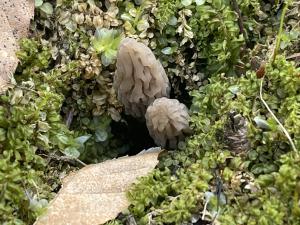 Today I found my first morel mushrooms of the year. A friend had texted me earlier in the day saying she’d found some. Had she not texted me, I wouldn’t have been on high alert during my hike, and I might’ve missed them. They were exactly where they should’ve been: in a mossy patch on the side of a hill, near other fungal activity, yet set apart from the neighboring fungi. They don’t like to mingle with fellow ‘shrooms. They want their own turf.
Today I found my first morel mushrooms of the year. A friend had texted me earlier in the day saying she’d found some. Had she not texted me, I wouldn’t have been on high alert during my hike, and I might’ve missed them. They were exactly where they should’ve been: in a mossy patch on the side of a hill, near other fungal activity, yet set apart from the neighboring fungi. They don’t like to mingle with fellow ‘shrooms. They want their own turf.
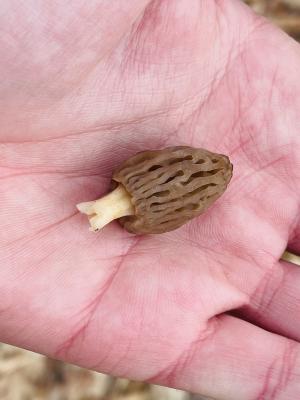 I’d like to say I wasn’t surprised to see them in that spot, but spotting a morel is always a startling event. And then in retrospect, you think “Of course, of course, they were there. If I were a morel, I’d be there too.” Everything’s obvious in retrospect.
I’d like to say I wasn’t surprised to see them in that spot, but spotting a morel is always a startling event. And then in retrospect, you think “Of course, of course, they were there. If I were a morel, I’d be there too.” Everything’s obvious in retrospect.
Morels seem to be fond of fringes, edges of things. You’ll find them on the edge of a path, or the edge of a driveway, or on the fringe of the moss, or hugging a row of bushes. They enjoy the collision of dry and wet, sand and grass, asphalt and dirt. They want to be near something, but not too near something. They exist in a liminal zone — a threshold, a boundary, a transition.
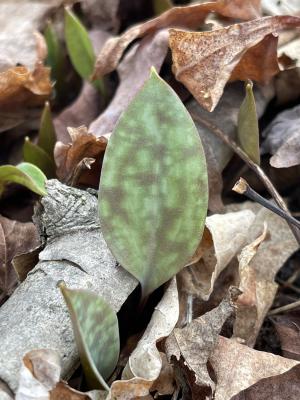 Accordingly, they arrive at the most liminal moment of the year, the moment we’re in right now: the edge of true spring.
Accordingly, they arrive at the most liminal moment of the year, the moment we’re in right now: the edge of true spring.
The year is at a tipping point as I write. We’re seeing the first hints of green on the trees. The first Dutchman’s breeches are blooming, but the trout lilies — notably — 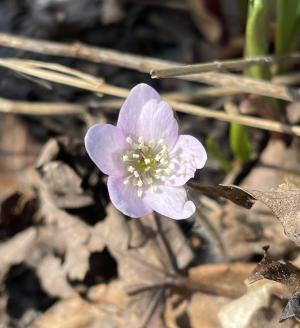 aren’t blooming yet. Hepatica and spring beauty wildflowers are thriving in the sun, and the trillium is about to pop, but — notably — they haven’t yet. Ramps are…I’m sorry, I can’t resist…ramping up. White bloodroot flowers are emerging from their cocoon-like sheath. Meadow rue and columbine leaves (so easy to mistake for each other!) are fanning out, with limitless ambition, as though they could take over the world. Scarlet cup fungus is bewitching the forest floor with fillips of dashing color.
aren’t blooming yet. Hepatica and spring beauty wildflowers are thriving in the sun, and the trillium is about to pop, but — notably — they haven’t yet. Ramps are…I’m sorry, I can’t resist…ramping up. White bloodroot flowers are emerging from their cocoon-like sheath. Meadow rue and columbine leaves (so easy to mistake for each other!) are fanning out, with limitless ambition, as though they could take over the world. Scarlet cup fungus is bewitching the forest floor with fillips of dashing color.
This is my favorite time of year. By far. Because it’s the most poetic time of year. All is promise and potential. Nothing has faded, nothing is past its prime. Everything is exciting and “still to be enjoyed,” to quote Keats’s Ode on a Grecian Urn — a poem which my teacher Jack Driscoll at Interlochen Arts Academy matter-of-factly called the greatest poem in the English language. The urn’s vignettes depict moments of perfection which are frozen in time, before consummation, and before decay.
“Heard melodies are sweet, but those unheard
Are sweeter…”
“Bold Lover, never, never canst thou kiss,
Though winning near the goal yet, do not grieve;
She cannot fade, though thou hast not thy bliss,
For ever wilt thou love, and she be fair!”
Beginnings of green on today’s trees cheer the soul, but they’re also ominous: the more leaves, the fewer spring wildflowers. An umbrella-like canopy of leaves will prevent sunlight from reaching the forest floor, leading to the demise of Dutchman’s breeches, trillium, et al. It’s a tradeoff.
As I wrote in one of my own poems:
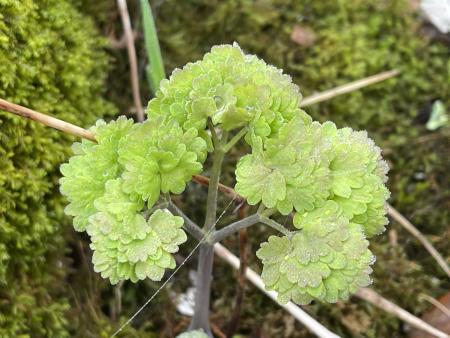 “Welcome the bright green canopy
“Welcome the bright green canopy
But understand it spells
The end of early wildflowers
The darkening of the dells”
And in another poem of mine, I wrote:
“May means May is over
The start invites the end.”
What I was saying there is that May is at its most real when it’s still in our imaginations. April is the real May. March is the real April. February is the real March. Christmas Eve is the real Christmas. And so on. Perhaps some of you are enlightened enough to “live in the moment,” and I congratulate you! But for the rest of us, anticipation is appreciation. Consummation is ruination. The arrival vanquishes the arrived. And the cusp is the actual climax.
Another poem that must be mentioned in this train of thought is Robert Frost’s Nothing Gold Can Stay, which I’ll print in full because it’s so short and (bitter)sweet and perfect:
 Nature's first green is gold,
Nature's first green is gold,
Her hardest hue to hold.
Her early leaf's a flower;
But only so an hour.
Then leaf subsides to leaf,
So Eden sank to grief,
So dawn goes down to day
Nothing gold can stay.
Right now is the perfect time, the pregnant time, with the belly of earth bursting at the seams. You can almost hear the ramps growing taller, in slow motion, and feel the vibrations of later arrivals like lady’s slippers and jack-in-the-pulpits eager to pierce through the soil. (Or are those vibrations coming from a grouse drumming on a log? I heard three of them today!) Spring is about to explode. If I could freeze today in amber, and live today like Groundhog’s Day in an endless loop…I would. Though I’m not a parent, I can empathize with the experience of wanting time to slow down, and feeling like my babies are growing up too fast. It’s all too fleeting.
Above all, what spring represents is the concept of becoming. Everything is becoming something right now — at its own pace, and in its own way.
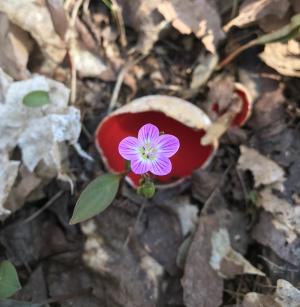 Some things wake up from a deep winter sleep and are raring to go immediately, like the hibernating mourning cloak butterflies, admiral butteries, and spring peepers. Some things lollygag before becoming themselves, like the lagging trout lilies. Some things are here year-round, even in winter — like the ubiquitous Herb Robert, or the moss, or the wintergreen — but now they’re refreshing and renewing themselves; replenishment is a form of becoming. Some things become greater versions of themselves inch by inch, little by little, gradually, like the spruces with their (delicious, I’m told!) bright green spruce tips. Some things are embarking on an odyssey, like the young tight-fisted meadow rue, the purple fringes of which forecast an autumnal apotheosis. Some things become brazenly, and some things become cautiously. There’s no wrong way to become.
Some things wake up from a deep winter sleep and are raring to go immediately, like the hibernating mourning cloak butterflies, admiral butteries, and spring peepers. Some things lollygag before becoming themselves, like the lagging trout lilies. Some things are here year-round, even in winter — like the ubiquitous Herb Robert, or the moss, or the wintergreen — but now they’re refreshing and renewing themselves; replenishment is a form of becoming. Some things become greater versions of themselves inch by inch, little by little, gradually, like the spruces with their (delicious, I’m told!) bright green spruce tips. Some things are embarking on an odyssey, like the young tight-fisted meadow rue, the purple fringes of which forecast an autumnal apotheosis. Some things become brazenly, and some things become cautiously. There’s no wrong way to become.
As you hike Empire Bluff, Clay Cliffs, or Alligator Hill (three springtime delights) on a perfect April day, maybe ask yourself “What am I becoming?” Because, as much as we might want to press pause and exist in Keats’s eternally “uravished” urn, time prods us onward, pokes us forward, and we inevitably grow and transform — just like the trees, flowers, and morels.
And if the ephemerality and transience of it all is haunting you with feelings of bittersweetness, then think about this: soon will come the swimming, the boating, and the beach bonfires of summer. I’m not sure that makes up for the loss of scarlet cup fungus. But it’s a pretty darn good consolation prize.
